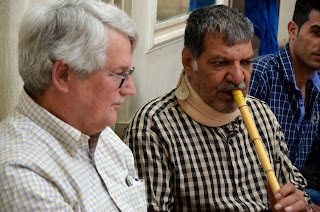Blog 12: Esfahan Public Bath, Pigeon Tower and Male Iranian Gymnasium
 |
| Public Bath |

Amin explains to us that historically the public bath was about more than getting clean, rather it was a place to socialize, gossip, get a full body massage, a shave, drink tea and smoke. Apparently no one went naked here and private parts were always covered with red blankets. John comments that he liked the all marble Turkish bath setting better than this one. Amin explains that the Iranian baths unlike the Turkish ones don’t supply prostitutes.
Pigeon Tower
 |
| Pigeon Tower |
These
huge edifices built with brick overlaid with plaster look like giant chess
pieces and provide many stories of nesting boxes for pigeons not for their eggs
or for eating, rather for their guano used to fertilize the local melon
fields.
 There are more than 500
pigeons in this tower but they only come to this tower at night, so we see only
two pigeons on this visit. Using
this natural fertilizer farmers don’t have to use chemicals. Why don’t we do
this in America? Zanny and I walk
up the stairs to the roof top for a great view of the city.
There are more than 500
pigeons in this tower but they only come to this tower at night, so we see only
two pigeons on this visit. Using
this natural fertilizer farmers don’t have to use chemicals. Why don’t we do
this in America? Zanny and I walk
up the stairs to the roof top for a great view of the city.
Gymnasium
Next we go to the gymnasium (zurkhanehs) one of my favorite
experiences of the whole trip. Since pre-Islamic times, men have met to
exercise in these octagonal buildings. The building has a sunken area in the
middle where we see 12 men jump down in a ritual that involves touching the ground
and touching their forehead before starting to exercise.
There are some seats
for spectators but the four of us are the only audience that day. Typically
this is gender-segregated to male spectators so I feel lucky to be allowed to
view this age-old tradition. The walls are decorated with many photographs of
past and present wrestlers as well as other traditional objects.
The morshid (leader) meets us and is particularly impressed with John and in a tribute he plays the flute and says a prayer to honor physicians.
The men, ages 18 to 85, weight lift using huge wooden boards which are too heavy for me to lift as well as wooden clubs. They exercise in unison using rigorous routines following the beat and song of the morshid.

Several times a few “elders” arrive and the men stop their exercise to respect and shake hands with them.
One of the elders who looks very fragile changes into the traditional sports outfit and joins the other men with the clubs. We guess he is about 85 years old and know that we couldn’t do what he is doing!
It is a touching and intimate experience to see this old tradition being passed down across many generations. Although it started pre-Islam it now includes Muslim traditions as many of the songs sung by the leader referenced Allah as well as reciting poems by Rumi and Fedosi. We ask Amin about such exercise programs for women which don’t seem to be available. I wonder how women would exercise with headscarfs and hijabs.











No comments:
Post a Comment